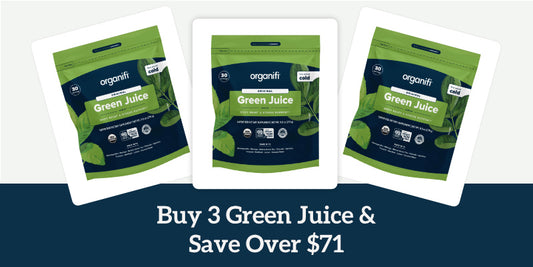It’s Saturday morning, you’re cruising down the fresh vegetable aisle in the supermarket and start loading the cart with carrots, potatoes, celery, broccoli, tomatoes, and then you see it: a white looking carrot - a parsnip. But you leave it behind.
After all, you already got carrots and potatoes and what is a parsnip anyway? How do you even cook it? Eat it?
Oooh, that dragon fruit looks good.
But I digress, poor guy got left behind, and you never got to enjoy the amazing parsnip nutrition benefits we’re about to tell you about!
Root vegetables are often overlooked:
Because dark leafy greens have a strong reputation for being healthy, and root veggies tend to have a lot of carbs, the latter is often ignored and left out of our plates and blenders in an effort to “eat healthy.”
Nothing could be further from the truth!
Yes, we love a good green juice reset, but root vegetables and legumes are just as healthy as their cruciferous counterparts; each of nature’s gifts has different flavors, minerals, vitamins, and phytonutrients that are necessary parts of a well-balanced diet.
You’d hardly ever hear someone say, “What is broccoli?” But you’ll often hear them say, “What is a parsnip?”
Parsnips are Surprisingly Tasty - and Healthy - Root Veggies
What is a parsnip you ask?
It’s delicious, rich, root vegetable loaded with impressive nutrition benefits that originated in Eurasia and has been used for centuries in Chinese Medicine to treat colds and coughs, arthritis pain relief, and improved gut health.
Parsnips, aka as pastinaca sativa, are members of the carrot family (Apaiaceae), but taste quite different from carrots and provide other health benefits that differ from those of their orange-colored cousins.
People often confuse them with carrots due to their shape, but unlike the former, they’re not as tasty in the raw. They’re better juiced, boiled, stewed, or baked.
Parsnip Nutrition Through the Ages
Parsnips have not always been one of nature’s best- kept secrets, they have been cultivated for over 2,000 years and the Romans ate it with honey as a delicacy and aphrodisiac.
It was such a delightful treat that it is believed Roman emperor Tiberius accepted parsnips as tribute from the people of what is Germany today.
So what is a parsnip? It’s the food of emperors!
Meanwhile, in China, it was used as a herbal infusion, boiled or pureed for its health benefits. Today, parsnip nutrition is key for Parma ham producers in Italy, who use it to feed their pigs.
When Are Parsnips in Season?
Parsnips are a cool climate root; they traditionally leverage frost to turn starch into sugar, developing a sweet and nutty flavor.
Since they require frost to gather its strength and distinctive taste, parsnips are best served during mid and late winter, but you can buy them from fall to spring.
Parsnip Nutrition and Health Benefits That Will Surprise You
What is a parsnip going to do for you? A lot!
According to the USDA seasonal produce guide, one cup of parsnips has:
- 0 gr of Fat
- 0 gr of Cholesterol
- 2 gr of Protein
- 7 gr of Fiber (26% DRI)
- 24 gr of Carbohydrates (8% DRI)
- 13 mg of Sodium (1% DRI)
- 48 mg of Calcium (4% DRI)
- 298 mg of Potassium (11% of the DRI)
- Vitamin C (28% DRI)
- Folate (22% DRI)
- Manganese (20 DRI)
What is a parsnip also rich in? Vitamin K, E, Zinc, Iron, Calcium and Phosphorus. From a nutritional point of view, parsnips are great for optimum eye, heart, gut, and respiratory function, but we’re partial to these top three parsnip nutritional benefits.
1. May Help with Eye Health with Vitamin C
Because of its high Vitamin C content, parsnip consumption may help prevent macular degeneration since studies show that most people who develop this condition suffer from low Vitamin C levels.
What is a parsnip to Macular degeneration?
Vitamin C is a staple of parsnip nutrition and it helps prevent degenerative sight, which leads to legal blindness in 90% of macular degeneration cases.
2. May Improve Gut Health with Soluble Fiber
With 26% of the daily recommended fiber intake, parsnip nutrition promotes healthy bowel movements, helps digestion, and relieves constipation symptoms.
In a study, aptly titled “White Vegetables: a Forgotten Source of Nutrients”, researchers noted that white vegetables -like parsnips- are rich in soluble fiber, which is the best kind for adequate gut health, and that “American women and men consume an average of only ∼15 gr of fiber per day, short of the 25 to 30 gr recommended daily intake.”
3. May Help Healthy Gestation with High Folate Content
Folate is an incredibly critical nutrient for pregnant women and developing babies, and what is a parsnip cup full of? Folate, aka folic acid, harboring a whopping 22% of the recommended daily intake!
Folic Acid or folate is part of the Vitamin B complex (Vitamin B9) and it is used by our bodies to make genetic material and DNA, for cells to divide and grow, and to aid brain function.
Parsnip also has Vitamin B6, thiamin, and pantothenic acid.
Parsnip nutrition may be a great addition for gestating mothers, in addition to its sweet and comforting flavor.
4. May Lower Glucose and Cholesterol Levels
Even though parsnips are sweet, their very high soluble fiber levels may help healthy and diabetic individuals process fat and sugar in the blood. According to this study both LDL Cholesterol and Glucose levels decreased by 12% when exposed to 4.11 gr of soluble fiber for three months.
This shows that parsnip nutrition may be beneficial as one cup of parsnip has 7 grams of soluble fiber, nearly double the trial.
5. Anti-inflammatory, Antifungal, and Cancer-Fighting Properties
Due to a natural compound and potent antioxidant called falcarindiol present in parsnip nutrition, parsnips have anti-inflammatory properties. Research shows that falcarindiol inhibits pro-inflammatory molecules.
Additionally, parsnips also have falcarindiol, panaxydiol, and methyl-falcarindiol, which are also antioxidants that may have both antifungal and anti-cancer properties, according to this study.
These compounds are common to the Apiaceae family, which includes carrots, celery, parsnip, and parsley!
Now if that doesn’t make you start drinking carrot, celery and parsnip juice, I don’t know what will.
6. Asthma, Sinus, Wheezing and Cough Relief
What is a parsnip, a simple parsnip, to do with your respiratory health? More than you can imagine, although at this point, it is clear that parsnip nutrition is no joke.
Parsnips are rich in Vitamin K and carotenoids, just like carrots, which aid respiratory functions and improve pulmonary function. They also alleviate sinus, asthma, and cough/wheezing symptoms.
7. More Radiant Skin, Stronger Bones and Teeth
Due to the uncanny Vitamin C levels present in one serving of parsnip, you can expect continued consumption to lead to more radiant skin. And with 47.9 gr of Calcium per cup, it is also reasonable to say that they contribute to strong bones and healthy teeth.
By now, you’re definitely desperate to get some parsnip nutrition in your life - and so are we!
Get the health benefits of Parsnip in Juices and Roasts
What is a parsnip recipe you can try today? Simple: just add parsnip to your favorite morning juice recipe, or try one of these easy juices.
Our favorite, super easy parsnip juices:
- Ginger, Green Apple, Parsnip Juice: Blend one cup of parsnip with one green apple and one small (one inch) piece of fresh ginger root.
- ABCP Juice: Simply add half a cup of uncooked parsnip to your favorite Apple, Beetroot, Carrot juice.
- Carrot, Orange, Parsnip Juice: blend in equal parts fresh orange juice, parsnip and carrots, to get an eye-health booster.
What is a Parsnip if not a winter staple? Roast it up to get the best of this creamy vegetable, and have it as a healthy winter recipe.
Quick Roasted Parsnip Meals:
- Oil-Free Roasted Vegetables by Minimalist Baker. Only 169 calories, combines parsnip with other winter roots and uses one pan only. Snatch the recipe here.
- Vegan Parsnip and Carrot Latkes by May I Have That Recipe: what is a parsnip doing in a Latke? Just try it! Recipe here.
- Simple Roasted Parsnips by Healthy Seasonal Recipes: probably the easiest and simplest recipe you can try to get parsnip nutrition going. Just chop, season, and toss in the oven. Recipe here.
Pair your roasted parsnips (add other good-for-you root veggies like beets and carrots for the ultimate winter medley) with Organifi Gold for a delicious and healthy winter snack.
To Recap:
What is a parsnip?
It’s an often overlooked root vegetable filled with nutritional properties we all need in our lives: Vitamin C, B, K, Folic Acid, Calcium, Phosphorus, Soluble Fiber, Carotenes, and more. It’s sweet and creamy and goes well with pretty much any juice combo you can think of.
It can also be boiled, pureed, sauteéd or roasted for a healthy winter meal.
What is a parsnip to do to get your attention? Go get some today to help protect your eyes, lungs, skin, bones, teeth, and heart!
Tell us what recipes you tried and if anyone asks “what is a parsnip”? Send them over to this parsnip nutrition post and spread the white-veggie love.




